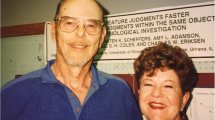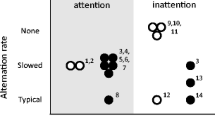Abstract
Milner and Goodale (The visual brain in action, Oxford Press, 1995) made a distinction between vision for perception and vision for action. In contrast to perception, many action tasks have strict temporal constraints, which can only be met if the visual information is relayed directly to the motor system without first passing through a conscious decision making process. Milner and Goodale therefore predict that visual stimuli do not have to reach visual awareness in order to guide rapid motor responses. Online visual feedback provides a good example of visual information that is used under tight temporal constraints to guide rapid motor responses. Online visual feedback provides information about the position of the moving limb. This information can be used to improve the accuracy of our movements. If vision for action operates independently of visual awareness, visual feedback should be beneficial even if the subject is unaware of this information. We tested this prediction in a patient (V.E.) with left-sided visual extinction, a condition in which a visual stimulus typically fails to reach awareness if a second stimulus is presented simultaneously at a more rightward location. V.E. was asked to point towards a central target with his left hand. In some trials a light-emitting diode (LED) provided brief visual feedback from the moving hand. However, in the majority of trials, V.E. was unaware of this LED, due to his extinction. His performance was nevertheless significantly better when visual feedback was present, regardless of whether or not the information was available for verbal report. We conclude that visual awareness is not essential for the effective use of online visual feedback.



Similar content being viewed by others
References
Bender MB (1952) Disorders in perception with particular reference to the phenomenon of extinction and displacement. Charles C. Thomas, Springfield
Berti A, Frassinetti F, Umilta C (1994) Nonconscious reading? Evidence from neglect dyslexia. Cortex 30:181–197
Churchill A, Hopkins B, Roenqvist L, Vogt S (2000) Vision of the hand and environmental context in human prehension. Exp Brain Res 134:81–89
Connolly JD, Andersen RA, Goodale MA (2003) FMRI evidence for a ‘parietal reach region’ in the human brain. Exp Brain Res 153:140–145
Culham JC, Kanwisher NG (2001) Neuroimaging of cognitive functions in human parietal cortex. Curr Opin Neurobiol 11:157–163
Desmurget M, Epstein C, Turner R, Prablanc C, Alexander G, Grafton S (1999) Role of the posterior parietal cortex in updating reaching movements to a visual target. Nat Neurosci 2:563–567
Driver J (1996) What can visual neglect and extinction reveal about the extent of “preattentive” processing. In: Kramer AF, Cole MGH, Logan GD (eds) Convergent operations in the study of visual selective attention. APA Press, Washington DC, pp 193–224
Driver J, Vuilleumier P (2001) Perceptual awareness and its loss in unilateral neglect and extinction. Cognition 79:39–88
Jakobson LS, Goodale MA (1989) Trajectories of reaches to prismatically-displaced targets: evidence for “automatic” visuomotor recalibration. Exp Brain Res 78:575–587
Marquardt C, Mai N (1994) Computational procedures for movement analysis in handwriting. J Neurosci Meth 52:39–45
McIntosh RD, McClements KI, Schindler I, Cassidy TP, Birchall D, Milner AD (2004) Avoidance of obstacles in the absence of visual awareness. Proc Royal Soc B 271:15–20
Milner AD, Goodale MA (1995) The visual brain in action. Oxford Press, Oxford
Pisella L, Grea H, Tilikete C, Vighetto A, Desmurget M, Rode G et al. (2000) An ‘automatic pilot’ for the hand in human posterior parietal cortex: toward reinterpreting optic ataxia. Nat Neurosci 3:729–736
Schenk T, Mair B, Zihl J (2004) The use of visual feedback and on-line target information in catching and grasping. Exp Brain Res 154:85–96
Schindler I, Rice NJ, McIntosh RD, Rossetti Y, Vighetto A, Milner AD (2004) Automatic avoidance of obstacles is a dorsal stream function: evidence from optic ataxia. Nat Neurosci 7:779–784
Volpe BT, Ledoux JE, Gazzaniga MS (1979) Information processing of visual stimuli in an “extinguished” field. Nature 282:722–724
Wilson B, Cockburn J, Halligan PW (1987) Behavioural inattention test. Thames Valley Test Company, Hampshire
Acknowledgements
This work was supported by grants from the Leverhulme Trust (Grant number: F/00128/O) and the UK Medical Research Council (Grant number G0000680).
Author information
Authors and Affiliations
Corresponding author
Additional information
The study was carried out at: Cognitive Neuroscience Research Unit (CNRU), Wolfson Research Institute, University of Durham, UK
Rights and permissions
About this article
Cite this article
Schenk, T., Schindler, I., McIntosh, R.D. et al. The use of visual feedback is independent of visual awareness: evidence from visual extinction. Exp Brain Res 167, 95–102 (2005). https://doi.org/10.1007/s00221-005-0027-9
Received:
Accepted:
Published:
Issue Date:
DOI: https://doi.org/10.1007/s00221-005-0027-9




